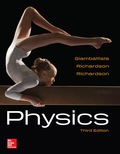
Concept explainers
(a)
At what time does the ball reach its maximum height?
(a)
Answer to Problem 83P
The ball reach its maximum height at
Explanation of Solution
The graph shown plots the velocity-time graph of the ball. When the ball reaches the maximum height, its velocity will be zero there. From the graph at time
Conclusion
Therefore, The ball reach its maximum height at
(b)
For how long is the ball in contact with the floor?
(b)
Answer to Problem 83P
The ball remains in contact with the floor for time of
Explanation of Solution
The graph shown plots the velocity-time graph of the ball. The time for which the ball remains in contact with the floor is equal to the time for which the ball makes a transition from its extreme negative velocity point to extreme positive velocity.
Write the equation to find the time of transition of ball.
Here,
Conclusion:
Substitute
Therefore, The ball remains in contact with the floor for time of
(c)
What is the maximum height reached by the ball?
(c)
Answer to Problem 83P
The maximum height reached by ball is
Explanation of Solution
Write the equation to find the maximum height reached by the rocket.
Here,
Substitute
Conclusion:
Substitute
Therefore, The maximum height reached by ball is
(d)
What is the acceleration of the ball while in the air?
(d)
Answer to Problem 83P
The acceleration of the ball while in the air is
Explanation of Solution
Write the equation to find the acceleration of the ball.
Here,
Conclusion:
Substitute
Since the acceleration is negative, it is acting down wards.
Therefore, The acceleration of the ball while in the air is
(e)
What is the average acceleration of the floor while in contact with the floor?
(e)
Answer to Problem 83P
The average acceleration of the ball is
Explanation of Solution
Write the equation to find the average acceleration of the ball.
Here,
Conclusion:
Substitute
Since the acceleration is positive, it is acting upwards.
Therefore, The average acceleration of the ball is
Want to see more full solutions like this?
Chapter 2 Solutions
Physics
- Hi! I need help with these calculations for part i and part k for a physics Diffraction Lab. We used a slit width 0.4 mm to measure our pattern.arrow_forwardExamine the data and % error values in Data Table 3 where the angular displacement of the simple pendulum decreased but the mass of the pendulum bob and the length of the pendulum remained constant. Describe whether or not your data shows that the period of the pendulum depends on the angular displacement of the pendulum bob, to within a reasonable percent error.arrow_forwardIn addition to the anyalysis of the graph, show mathematically that the slope of that line is 2π/√g . Using the slope of your line calculate the value of g and compare it to 9.8.arrow_forward
- An object is placed 24.1 cm to the left of a diverging lens (f = -6.51 cm). A concave mirror (f= 14.8 cm) is placed 30.2 cm to the right of the lens to form an image of the first image formed by the lens. Find the final image distance, measured relative to the mirror. (b) Is the final image real or virtual? (c) Is the final image upright or inverted with respect to the original object?arrow_forwardConcept Simulation 26.4 provides the option of exploring the ray diagram that applies to this problem. The distance between an object and its image formed by a diverging lens is 5.90 cm. The focal length of the lens is -2.60 cm. Find (a) the image distance and (b) the object distance.arrow_forwardPls help ASAParrow_forward
 College PhysicsPhysicsISBN:9781305952300Author:Raymond A. Serway, Chris VuillePublisher:Cengage Learning
College PhysicsPhysicsISBN:9781305952300Author:Raymond A. Serway, Chris VuillePublisher:Cengage Learning University Physics (14th Edition)PhysicsISBN:9780133969290Author:Hugh D. Young, Roger A. FreedmanPublisher:PEARSON
University Physics (14th Edition)PhysicsISBN:9780133969290Author:Hugh D. Young, Roger A. FreedmanPublisher:PEARSON Introduction To Quantum MechanicsPhysicsISBN:9781107189638Author:Griffiths, David J., Schroeter, Darrell F.Publisher:Cambridge University Press
Introduction To Quantum MechanicsPhysicsISBN:9781107189638Author:Griffiths, David J., Schroeter, Darrell F.Publisher:Cambridge University Press Physics for Scientists and EngineersPhysicsISBN:9781337553278Author:Raymond A. Serway, John W. JewettPublisher:Cengage Learning
Physics for Scientists and EngineersPhysicsISBN:9781337553278Author:Raymond A. Serway, John W. JewettPublisher:Cengage Learning Lecture- Tutorials for Introductory AstronomyPhysicsISBN:9780321820464Author:Edward E. Prather, Tim P. Slater, Jeff P. Adams, Gina BrissendenPublisher:Addison-Wesley
Lecture- Tutorials for Introductory AstronomyPhysicsISBN:9780321820464Author:Edward E. Prather, Tim P. Slater, Jeff P. Adams, Gina BrissendenPublisher:Addison-Wesley College Physics: A Strategic Approach (4th Editio...PhysicsISBN:9780134609034Author:Randall D. Knight (Professor Emeritus), Brian Jones, Stuart FieldPublisher:PEARSON
College Physics: A Strategic Approach (4th Editio...PhysicsISBN:9780134609034Author:Randall D. Knight (Professor Emeritus), Brian Jones, Stuart FieldPublisher:PEARSON





